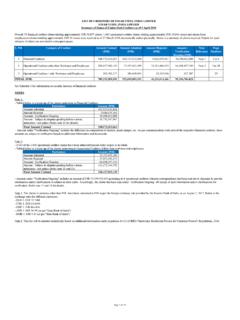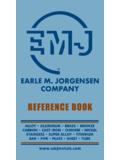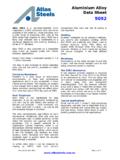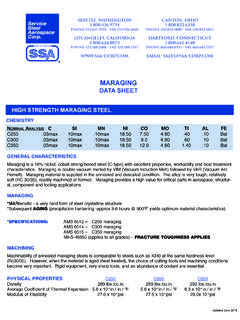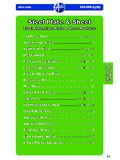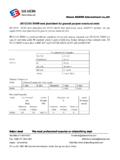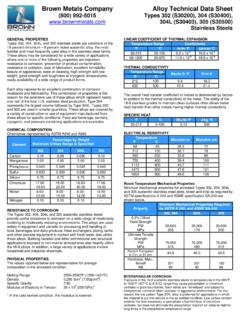Transcription of Design of high strength steel for long member of …
1 Design of high strength steel for long member of trucks and commercial vecleshi BY. DR. M. VENKATRAMAN1, MS. SUMITRA DAS2. SYNOPSIS: The demands by the automotive industries to meet the environmental concerns such as global warming, CO2 emission etc. require materials for weight saving for fuel efficiency. Among the metallic materials that would meet these conflicting demands, steel has been proved to be the only choice available yet. The reduction in sheet thickness by use of high strength steel is being increasingly adopted as an effective means for weight reduction and increase in payload. In this paper Essar steel 's experience in development of high strength S650MC/ 80 Ksi grades steels for long member application in heavy duty commercial trucks is presented. These grades have been substituted in place of conventional 420 and 460. MPa strength steels. These high strength grades are designed to meet the complex loading behavior of long members and also provide significant weight saving potential.
2 Details of metallurgical product strengthening, Design principles, performance of material in actual line production are presented. Keywords: high strength steel , long member , bainite steel , HSLA steel 1. Sr. Vice President & Head- Product Development, Marketing- Essar steel Limited, Surat, Gujarat, India. 2. Manager-Product Development& Application Engg., Essar steel Limited,. Introduction: Transportation industry plays a major role in the economy of modern industrialized and developing countries. The total and relative volume of goods carried on trucks is dramatically increasing. The major focus in the truck manufacturing industries is Design of vehicles with more pay load. By using higher strength steels than the conventional ones, significant weight reductions are possible with corresponding increase in pay load capacity. The chassis of trucks which is the backbone of vehicles that integrates the main truck component systems such as the axles, suspension, power train, cab and trailer etc.
3 , is one of the possible candidates for significant weight reduction.[1-2] Substitution of higher strength steels for the chassis member offer substantial weight saving possibilities to the tune of 20% through proper Design of the chassis members. However the metallurgical Design 1. and properties needed for this application have to be carefully tailored to the end application since this component is the most critical component in the heavy vehicles. In this paper, the substitution of a high strength alloy (550 and 650 MPA YS) in place of conventional 420 MPa strength steel for a chassis frame of a 15 ton truck is presented. The metallurgical Design factors of development of the high strength alloy, the loading and service life of a long member in the vehicle is briefly presented. Finally a case study of practical application in a vehicle is given. Engineering Aspects of a Long member in a Truck Chassis frame consist of two channel shaped side member / long members, which are held apart by series of cross members ( ).
4 Cross members are positioned at points of high stress and are cold riveted to side member . The depth of the channel must be sufficient to minimize the deflection. Since the load at each point of the frame varies, a weight reduction can be achieved by either reducing the depth of the channel, or having a series of holes positioned along the neutral axis in the regions where the load is not so high . During movement of a vehicle over normal road surfaces, the chassis frame is subjected to both bending and torsional distortion. The open-channel sections exhibit excellent resistance to bending, but have very little resistance to twist. Therefore, both side and cross-members of the chassis must be designed to resist torsional distortion along their length. Generally for heavy commercial vehicle channel section is preferred over hollow tube due to high torsional stiffness. The chassis frame, however, is not designed for complete rigidity, but for the combination of both strength and flexibility to some degree.
5 The chassis frame supports the various components and the body, and keeps them in correct positions. The frame must be light, but sufficiently strong to withstand the weight and rated load of the vehicle without having appreciable distortion. It must also be rigid enough to safeguard the components against the action of different forces. The chassis Design includes the selection of suitable shapes and cross-section of chassis-members. Moreover, the Design should consider the reinforcement of the chassis side- and cross- member joints, and the various methods of fastening them together. [3]. 2. CROSS member . CHASSIS. LONG member . Skeleton of Truck Chassis frame The Design of an automobile chassis requires prior understanding of the kind of conditions the chassis is likely to face on the road. The chassis generally experiences four major loading situations, that include, [4]. i. vertical bending ii. longitudinal torsion iii. lateral bending, iv. horizontal lozenging. In addition there is torsion loading and fatigue loading.
6 Hence the material selected for this member must with stand the high bending loads, torsional loads and fatigue. In addition corrosion resistance is also important. Apart from chemical and mechanical properties, the critical requirements of this product are: . 3. i. Thickness Tolerance No negative thickness and narrow band thickness ii. Camber Max camber spec is 1mm/meter can effect flange height of C. channel iii. Length & Width Tolerance No negative in length and width. iv. Grain Size 7 or Finer v. Micro alloying element should not exceed vi. Material should be free from sliver, lamination, scabs and deep rolling marks. Manufacturing of Long Members Long members are made either by roll forming or press forming operations. Sometimes hydro formed components are used where stiffness supersedes other criteria [1] Press Forming Operation . Sheet metal forming processes are those in which force is applied to a piece of sheet metal to modify its geometry rather than remove any material.
7 The applied force stresses the metal beyond its yield strength , causing the material to plastically deform, but not to fail. By doing so, the sheet can be bent or stretched into a variety of complex shapes. This conventional process is used for grade to the strength level of 460 MPa. [2] Roll Forming Application . Roll Forming is a continuous bending operation in which a long strip is passed through consecutive sets of rolls or strands, each forming only an incremental part of the bend until the desired cross section profile is obtained. Roll Forming is carried out in multi stages and is considered to be the most ideal and economical manufacturing process for bulk quantity production. Roll forming operation 4. Following are the advantages of Roll Forming line over conventional press forming . i. Dimensional consistency ii. Low spring back iii. Adjustable roller facility in the machine enables to use the same tooling for different sections. Same set of roller can be used for different thickness and wedge width.
8 Iv. Input raw material is slit coils and the single line follows leads to lower man power cost. [3] Hydro forming operation . Hydro forming / Hydro form is a manufacturing process where fluid pressure is applied to a metallic blank / Tubes to form a desired component shape. This process requires hydro forming tools consisting of a punch made in the shape of the desired part, a ring contoured to fit around the punch, and a pressurized forming chamber sealed by a flexible rubber diaphragm. Tube hydro forming changes the cross-sectional shape of a tube from the normal round to other shapes that change along the part's length. Tooling for a hydro formed part is typically less expensive than for a deep drawn part, since only a punch and ring are required. Deep Drawing requires a punch, die, and blank holder. If the part is conducive to hydro forming and relatively small quantities are desired, hydro forming provides a cost effective solution to forming the part. Currently, it is being done for passenger car and SUV only.
9 Design of Alloy Based on the details of process of manufacturing the component and critical properties needed, the alloy has been designed to meet the required properties viz., strength Fatigue Corrosion Hardness Bending strength Minimum spring back Uniformity of properties high strength micro alloyed ferrite bainite steels, dual phase steels, ultra high strength steels are some of the grades which are recently developed world wide to meet all of the above properties for these advanced special applications. Yield strength in excess of approx 420 MPa in reasonable thicknesses and with good toughness could only be attained in micro alloyed (MA) steels with low transformation temperatures. Micro alloyed high strength steels processed at controlled temperatures 5. has mixture of polygonal, and bainitic and ferrite.[5] This evolution of microstructure during controlled rolling is schematically explained in Fig 3. Figure 3: Evolution of plate for long member : microstructure and mechanical properties [6].
10 Strengthening Mechanism: high - strength steels generally fall into three basic categories, classified by the strengthening mechanism employed. i. solid-solution-strengthened steels ii. grain-refined steels or high strength low alloy steels (HSLA). iii. Transformation-hardened steels. Solid solution strengthening relies mainly on addition of Mn, Si and C and P for strength . However, alloys solely based on solid solution strengthening mechanism lack formality and have low n value. Grain refinement technique to increase strength as well as toughness is the most effective metallurgical way to achieve combination strength , formability, toughness and elongation. Ti, Nb, V etc., are extensively used as an alloying element to achieve the combination of these critical properties. Another advantage is that these alloys can be designed with low carbon content for easy weldability. Titanium in low carbon steels forms into a number of compounds that provide grain refinement, precipitation strengthening and sulphide shape control.
